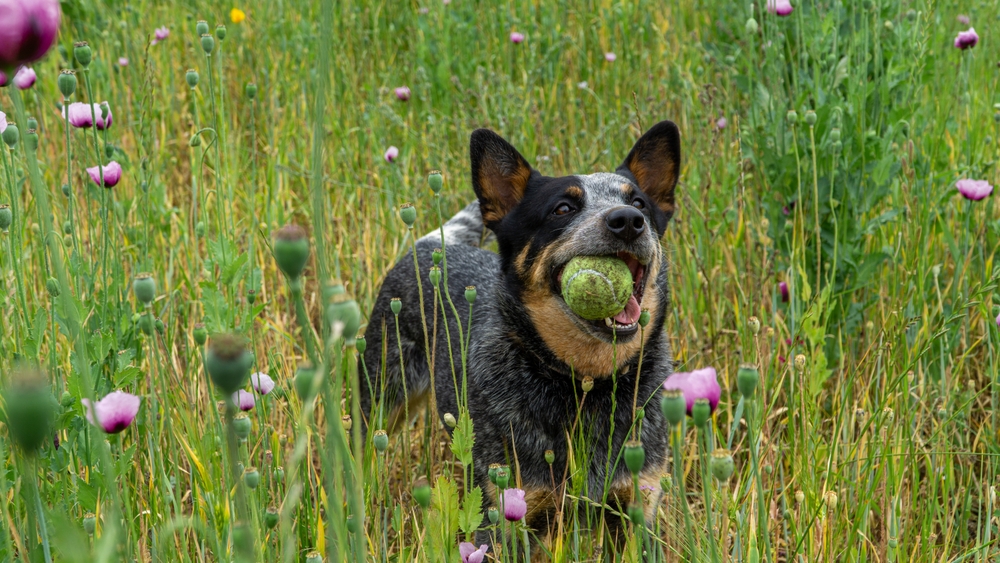Spring comes with so many benefits, from fresh air to sunshine, green grass, and the best smells. However, it can also introduce potential hazards into your pet’s environment. Some of these potential dangers are easy to manage, sure, such as seasonal allergies.
However, others could be no less than life-threatening, such as your dog getting into lawn fertilizer. Even with indoor items, it’s the same story: fresh-cut flowers and cleaning products can all harm your little friend. Veterinary toxicologist Renee Schmid, DVM, DABVT, DABT, gives us the full rundown on such potential hazards and how you should stay safe with your pet this spring.

Leave gardening to humans
Well, there are seal fertilizers, weed killers, and various other lawn-care containers that need to be kept out of your pets’ reach. Consuming such products could easily lead to upset stomach, vomiting, and diarrhea, especially if they get into a bag of product and start eating several mouthfuls.
You should contact your vet or a pet poison hotline if you think your pet ingested any of those chemicals. Sensitive pets who have fertilizer residue on their paws could easily experience skin irritation and minor stomach upset if they decide to lick their paws.
However, such symptoms will generally go away on their own. You can limit potential sensitivities by effectively keeping your pets off the lawn for the product’s advised waiting period after application.
Keep up with the flea and tick preventatives
It is absolutely mandatory to keep your pet up-to-date with the flea, tick, and heartworm prevention medication, especially this spring. Schmid advised discussing what options you have with your vet, since many tick products can kill the pest way before they transmit Lyme or other tick-borne diseases.
However, you should still strive to remove the tick as soon as you can. You can comb or brush your pets consistently after spending a lot of time outside, especially in heavily wooded and bushy areas.
In certain areas of America, ticks and Lyme disease are particularly prevalent. If you have an ongoing problem with ticks and you worry about your pet, you should talk to your veterinarian about vaccinating them against Lyme disease. Also, try to research which ticks are more common depending on the region you live in, using the Centers for Disease Control and Prevention.
Know your plants
As you start your journey of spring landscaping and gardening, make sure you stay aware of plants and trees that can be toxic to animals. In fact, the entire lily plant is very toxic to cats, causing them kidney failure, seizures, and death.
Oftentimes, lilies show up in floral arrangements, especially around spring holidays such as Easter and Mother’s Day. If you have a cat with a history of chewing plants, then you should keep the lilies out of your home and garden for your pet’s safety.
Moreover, try to look out for Japanese yew trees, which can contain toxins that would further cause heart rate and blood pressure issues if digested, but also bulbs of daffodils, tulips, and other types of flowers.
They can also hurt your stomach or cause you obstruction issues, especially if dug up and consumed. If you’re not sure whether or not a specific type of plant is safe for your pets, try to check the ASPCA library on plant toxicity for dogs and cats.
Watch out for bees
Well, when it comes to bee stings, their severity depends on where the pet was “targeted” by the bee. A sting with only a minor swelling on a paw, leg, or any other part of the body will likely not cause any major issues.
Moreover, Schmid recommends consulting a veterinarian about the use of over-the-counter Benadryl for the swelling. If it’s a sting on the face, on the other hand, then it could be something a bit more serious. If you also suspect your pet has been stung by a bee, you should call your vet right away and make sure you monitor it for signs of an allergic reaction.
Monitor seasonal allergies
Your pet could be allergic to outdoor allergens like pollen and grass, so make sure you keep an eye out for signs of irritation, whether it’s constant chewing or licking of the paws, constant and recurring eye infections, or overall itchy and scratchy skin.
Depending on how severe the allergy gets, there are both prescription and over-the-counter medications that could treat such symptoms. Discuss with your vet about what options could work best for you.
Update ID tags and microchip information
With all this extra time spent outside and enjoying the beautiful weather, make sure your pet has the right-fitting collar with a tag that easily gives away needed information, such as name, address, and phone number.
You also want to consider getting them microchipped, if they’re not already. If your pet is microchipped but you have changed the address since, you should find the time to update the contact information, in case your pet ever gets lost. This way, you will have an easier time getting them back home safe and sound.

Store cleaning products in secure locations only
If your family has been long planning to pick up on new spring cleaning projects, try to be intentional about where you store both the products and chemicals. Many cleaning products can be diluted, like multipurpose spray and countertop cleaner, which could cause stomach upset. More concentrated, heavy-duty cleaners could ultimately lead to more serious issues, such as mouth and esophageal ulcers.
You should store all the cleaning products out of reach for your pets, and keep them far away from any freshly cleaned areas until the products fully dry. If your pet gets in contact with a cleaning product they shouldn’t, call your veterinarian or even a pet poison hotline.
How to deal with allergies in dogs
If someone recently told you that their dog suffers from allergies and your veterinarian suggested a treatment, then you need to find the right list of hacks to tackle the issue. Allergies are nothing but a misguided reaction to foreign substances by the body’s immune system. There are different types of allergies in dogs. Whether it’s skin allergies, food allergies, or environmental ones, they all pose serious questions for dogs and their owners. To make things even worse, the symptoms of such allergies can often overlap.
Naturally, the best and first thing that needs to be considered is to avoid the cause of allergens, which might not always be so easy. Then, the type of treatment, depending on the type of allergy needs to be tackled with care. Luckily, as soon as you find it, you just have to stick to it.
For instance, the best way to treat flea allergy dermatitis is really to kill the fleas, whereas the most efficient way to treat a food allergy or food intolerance is simply to change the diet. Depending on the type and severity of the allergy, your veterinarian can prescribe a series of different things.
For hives, they could suggest antihistamines and cortisone as well as medicated shampoos, while those with food allergies should take fish oil and other Omega-3 fatty acid supplements.
If you found this article useful, we also recommend checking: Pet Distress Signs: 5 Ways to Know When a Pet Is Begging for Help












